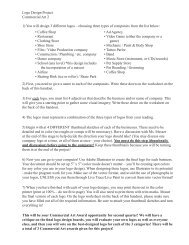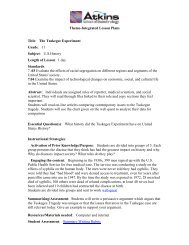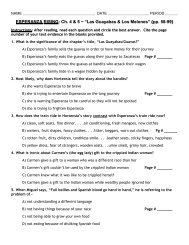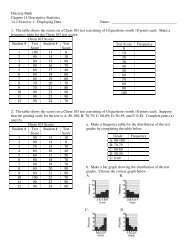Politics and the Gilded Age
Politics and the Gilded Age
Politics and the Gilded Age
- No tags were found...
Create successful ePaper yourself
Turn your PDF publications into a flip-book with our unique Google optimized e-Paper software.
Political Paralysis in <strong>the</strong> <strong>Gilded</strong><strong>Age</strong>1869 - 1896
Postwar United States• Population increased to 39 million by1870, making US 3 rd largest nation inwestern world• Political corruption rampant after <strong>the</strong>war– Idealism of Americans (fighting for Union<strong>and</strong> emancipation during <strong>the</strong> war) turnedto cynicism (because of corruption <strong>and</strong>waste)
Postwar United States• The <strong>Gilded</strong> <strong>Age</strong>– Used by Mark Twain to describe <strong>the</strong> 30years after <strong>the</strong> Civil War– “shiny <strong>and</strong> prosperous on <strong>the</strong> outside, but rottenon <strong>the</strong> inside” (Twain)
The “Bloody Shirt” Elects Grant• The election of 1868: <strong>the</strong> Republicans– Nominate Ulysses S. Grant– Grant was a popular war hero but had extremelylimited knowledge with anything outside hisimmediate experience (military, horses, etc.)– Republican platform called for continuedReconstruction in South with Grant’s call, “Let ushave peace.”– Republicans whipped up enthusiasm for Grant by“waving <strong>the</strong> bloody shirt” – reviving memories ofCivil War <strong>and</strong> Democratic rebellion
The “Bloody Shirt” Elects Grant• The election of 1868: <strong>the</strong> Democrats– Nominate Horatio Seymour– Democratic platform emerged out of dispute overmonetary policy• Rich easterners wanted federal war bonds paid backwith gold (although <strong>the</strong>y had been purchased withdepreciated greenbacks)• Poor, debtor midwesterners came up with <strong>the</strong> “OhioIdea”; wanted <strong>the</strong> bonds paid back with greenbacks (toput more money in circulation <strong>and</strong> keep interest rateslower)– Midwestern delegates got <strong>the</strong> Ohio Idea into <strong>the</strong>Democratic platform, but Seymour spoke outagainst it
The “Bloody Shirt” Elects Grant• The election of 1868: <strong>the</strong> results– Grant won <strong>the</strong> election• 214 to 80 electoral votes• 3 million to 2.7 million popular votes– Grant would not have won without freedmen’svotes• 300,000 margin in popular votes• 500,000 freedmen had voted for Grant• Republicans had to keep ex-slaves voting to stay inpower
The Election of 1868
The Era of Good Stealings• Postwar era was one of corruption <strong>and</strong>dishonest dealings– Although not everyone was dishonest,many people were– Businesspeople stole investors money,politicians <strong>and</strong> judges took bribes
The Era of Good Stealings• Millionaires “Jubilee Jim” Fisk <strong>and</strong> JayGould seek to corner <strong>the</strong> gold market(1869)– Corner <strong>the</strong> market - buy all or most of acommodity or stock so that its price goesup; once <strong>the</strong> price was high enough, buyerwould sell for a large profit
The Era of Good Stealings• Fisk’s <strong>and</strong> Gould’s plan would only work iffederal treasury did not sell any gold– Fisk <strong>and</strong> Gould got Grant’s bro<strong>the</strong>r-in-law, AbelCorbin, in on <strong>the</strong> scheme to stop Grant fromreleasing gold (paying Corbin $25,000)• Gold rises as Fisk <strong>and</strong> Gould bid <strong>the</strong> price up• September 24, 1869 – “Black Friday”– Gold finally released by US Treasury to end <strong>the</strong>scheme (supposedly contrary to Grant’s personalassurances to <strong>the</strong> schemers)• Congressional investigation found Grant wasstupid, but not crooked
The Era of Good Stealings• Boss Tweed <strong>and</strong> <strong>the</strong> Tweed Ring inNew York City– Used bribery, graft, <strong>and</strong> fraudulentelections to steal $200 million from citytreasury– Used taxes <strong>and</strong> intimidation to silenceprotests
The Era of Good Stealings• 1871 – Tweed destroyed by New York Times– Published irrefutable evidence of Tweed’scorruption– Tweed offered NY Times $5 million to not publish<strong>the</strong> evidence, but <strong>the</strong>y did anyway• Cartoonist Thomas Nast also attacked Tweed– Also offered bribe to stop cartooning, but herefused it– Complained that his followers (who couldn’t read)turned against him when <strong>the</strong>y saw “<strong>the</strong>m damnpictures”• Tweed prosecuted by New York attorneySamuel J. Tilden <strong>and</strong> died behind bars
A Carnival of Corruption• Corruption in Grant’s administrationwidespread <strong>and</strong> pervasive– Cabinet was filled with grafters <strong>and</strong>incompetent office seekers– People who wanted favors fromgovernment came to White House, givingGrant gifts to get favorable policies enacted
A Carnival of Corruption• Crédit Mobilier sc<strong>and</strong>al– Union Pacific Railroad insiders from <strong>the</strong> company,<strong>the</strong>n hired <strong>the</strong>mselves to build <strong>the</strong> line (at inflatedprices)– Distributed shares of stock to importantcongressmen to prevent investigation– 1872 investigation by newspaper <strong>and</strong> Congress ledto breakup of Crédit Mobilier, censure of 2congressmen– Vice President Schuler Colfax shown to havetaken bribes (dropped in 1872 by Grant)
A Carnival of Corruption• Whiskey Ring– 1874 – 1875 – group of distillers who bribedfederal agents to avoid paying millions inwhiskey taxes– Grant’s private secretary, Orville Babcocktook money from <strong>the</strong> group• Grant refuses to fire him• Grant’s testimony helps assure his acquittal
TheWhiskeyRing
A Carnival of Corruption• Indian l<strong>and</strong> bribes– 1876 – secretary of war William E. Belknaptook bribes from suppliers to Indianreservations– Belknap impeached <strong>and</strong> resigned– Grant stayed loyal to his friend until <strong>the</strong>end
The Liberal Republican Revolt of1872• Republicans split over disgust withcorruption (“Grantism”) in Grantadministration
The Liberal Republican Revolt of1872• Liberal Republicans campaign onremoving corrupt officials inWashington <strong>and</strong> ending militaryReconstruction in South– Nominated Horace Greeley, editor of NewYork Tribune; good editor, but tooideological <strong>and</strong> stubborn as politicalc<strong>and</strong>idate
The Liberal Republican Revolt of1872• Democrats endorse Greeley as <strong>the</strong>irnominee also– Greeley had long attacked Democrats as“traitors” (because of Civil War)– Greeley called for clasping h<strong>and</strong>s across“<strong>the</strong> bloody chasm” (abyss)
“Let Us Clasp H<strong>and</strong>s Over <strong>the</strong>Bloody Chasm”
The Liberal Republican Revolt of1872• Republicans renominate Grant forpresident• Campaign in 1872 was brutal– Greeley denounced as believer in exotic,discredited ideologies (communism,vegetarianism) <strong>and</strong> of being soft onSou<strong>the</strong>rn rebellion– Grant attacked for corruption in hisadministration <strong>and</strong> incompetence
The Liberal Republican Revolt of1872• Results of <strong>the</strong> 1872 election– Grant won with greater margin than 1868• 286 to 66 electoral votes• 3.5 to 2.8 million electoral votes
The Election of 1872
The Liberal Republican Revolt of1872• Republicans fixed major problems thatLiberal Republicans <strong>and</strong> Democrats broughtout, to prevent voter rebellion in futureelections– 1872 – general amnesty act passed; removedpolitical disabilities from all but 500 Confederateleaders– High tariffs (from <strong>the</strong> war) reduced– Mild civil-service reform enacted to get rid ofworst people from Grant’s administration
Depression, Deflation, <strong>and</strong>Inflation• Panic of 1873– Began as Grant’s 2 nd term began– Caused by over-expansion of railroads,mines, factories, farms, fueled by bad loansmade by banks– When profits didn’t come in, bank loansnot paid, <strong>and</strong> economy collapsed– Led to depression that lasted for 4 years
Depression, Deflation, <strong>and</strong>Inflation• Effects of <strong>the</strong> Depression– 15,000 businesses failed– Unemployed rioted <strong>and</strong> battled police inNew York City– Blacks hit hard when failed Freedmen’sSavings <strong>and</strong> Loan Company
Depression, Deflation, <strong>and</strong>Inflation• Greenbacks– $450 million in greenbacks issued during CivilWar– Had depreciated because it wasn’t backed by gold<strong>and</strong> because Supreme Court declared <strong>the</strong> lawunder which it was issued (Civil War LegalTender Act) unconstitutional in 1870 (although <strong>the</strong>Supreme Court reversed itself in 1871)– Treasury withdrew $100 million from circulationby 1868; in process of taking out more
Depression, Deflation, <strong>and</strong>Inflation• Debtors hit hardest by Depressioncalled for greenbacks to be issued toinflate (increase) money supply– More money meant cheaper money (<strong>and</strong>rising prices), making debts easier to payoff
Depression, Deflation, <strong>and</strong>Inflation• “hard money” Republicans won– Creditors argued against inflation because <strong>the</strong>ydid not want to be paid back in money worth lessthan <strong>the</strong> money <strong>the</strong>y had originally loaned(depreciated money)– 1874 – convinced Grant to veto a bill to print morepaper money– 1875 – Resumption Act of 1875 passed• Government would withdraw greenbacks fromcirculation• Repayment of all paper money in gold at face value by1879
Depression, Deflation, <strong>and</strong>Inflation• Silver– Early 1870s – treasury kept silver pegged at16 ounces to 1 ounce of gold– Silver on open market was worth morethan what treasury would pay, so minesstopped selling to treasury– 1873 – federal treasury stopped coiningsilver dollars
Depression, Deflation, <strong>and</strong>Inflation• Silver discoveries made in late 1870sincreased production <strong>and</strong> loweredprices• Western silver mining states joinedwith debtors who wanted inflation(through coinage of silver) to return tocoining silver (“Dollar of ourDaddies”), attacking <strong>the</strong> “Crime of ’73”)
Depression, Deflation, <strong>and</strong>Inflation• Deflation– Supporters of “hard money” got Grant to blockcoinage of silver– Treasury bought up gold (to have enough on h<strong>and</strong>to redeem greenbacks in 1879)– Treasury also continued taking greenbacks out ofcirculation– 1870 – 1880 – amount of money per capita incirculation decreased ($19.42 to $19.37)– Made depression worse, but improvedgovernment’s credit rating <strong>and</strong> got greenbacks upto full value of gold
Depression, Deflation, <strong>and</strong>Inflation• Reaction against Republican hardmoney policies– Democrats won House of Representativesin 1874– Greenback Labor party formed in 1878• Strong showing as 3 rd party presidential run• 14 seats in Congress
Pallid <strong>Politics</strong> in <strong>the</strong> <strong>Gilded</strong> <strong>Age</strong>• Political parties almost evenly matched (interms of support) throughout <strong>Gilded</strong> <strong>Age</strong>– Presidential elections always close– Control of Congress went back <strong>and</strong> forth between<strong>the</strong> 2 parties– Rarely did 1 party control Congress <strong>and</strong>presidency at same time– Meant that politicians were timid; focusing ontrivial instead of important issues
Pallid <strong>Politics</strong> in <strong>the</strong> <strong>Gilded</strong> <strong>Age</strong>• Democrats <strong>and</strong> Republicans basically agreedon important national issues of <strong>the</strong> time– Tariffs, civil-service, currency reform• Democrats <strong>and</strong> Republicans were still (in spitof <strong>the</strong>ir overall agreement) very competitive– High voter turnout (up to 80%)– Strong political feelings (for <strong>the</strong>ir chosen party)among electorate
Pallid <strong>Politics</strong> in <strong>the</strong> <strong>Gilded</strong> <strong>Age</strong>• How can <strong>the</strong> contradiction betweenbasic overall political agreement strongpolitical feelings be explained?– Because <strong>the</strong> 2 parties were divided byculture, ethnicity, <strong>and</strong> religion
Pallid <strong>Politics</strong> in <strong>the</strong> <strong>Gilded</strong> <strong>Age</strong>• Republican voters– Belief system traced back to Puritanism– Government should regulate economic <strong>and</strong>moral affairs of society– Strongest in Midwest <strong>and</strong> rural <strong>and</strong> smalltownNor<strong>the</strong>ast, along with blacks in South<strong>and</strong> Union veterans from Civil War
Pallid <strong>Politics</strong> in <strong>the</strong> <strong>Gilded</strong> <strong>Age</strong>• Democratic voters– Immigrant Lu<strong>the</strong>ran <strong>and</strong> Roman Catholicsimportant– Believed in toleration in imperfect world,less stern than Republican Puritanism– Rejected government efforts to regulatemorality– Strongest in South <strong>and</strong> nor<strong>the</strong>rn industrialcities (with large number of immigrants)
Pallid <strong>Politics</strong> in <strong>the</strong> <strong>Gilded</strong> <strong>Age</strong>• Patronage– Disbursement of jobs <strong>and</strong> favors tosupporters in return for votes– Very important to both political parties
Pallid <strong>Politics</strong> in <strong>the</strong> <strong>Gilded</strong> <strong>Age</strong>• Republican divisions over patronage– “Stalwarts”• Led by Roscoe Conkling, US senator from New York• Strongly believed in using patronage for politicaladvantage– “Half-Breeds”• Led by James G. Blaine, congressman from Maine• Supposedly favored civil-service reform• In reality wanted to take power from Stalwarts to controlwho gave out <strong>the</strong> jobs under patronage– Nei<strong>the</strong>r side was ever successful in controllingRepublican party (by defeating opposing side)
The Hayes-Tilden St<strong>and</strong>off, 1876• The election of 1876: <strong>the</strong> Republicans– Grant considered a 3 rd term, until <strong>the</strong>House passed a resolution condemning <strong>the</strong>idea– Ru<strong>the</strong>rford B. Hayes, former 3-termgovernor of Ohio, chosen as nominee• Ohio important (<strong>and</strong> populous) swing state at<strong>the</strong> time
The Hayes-Tilden St<strong>and</strong>off, 1876• The election of 1876: <strong>the</strong> Democrats– Nominated Samuel J. Tilden• Best known as man who had prosecuted BossTweed– Tilden campaigned on platform againstRepublican sc<strong>and</strong>al
The Hayes-Tilden St<strong>and</strong>off, 1876• The election of 1876: <strong>the</strong> results– Tilden won more popular votes than Hayes (4.28to 4.0 million)– Tilden had 184 (of needed 185) electoral votes forvictory– 4 states (Oregon, South Carolina, Louisiana,Florida) had disputed electoral returns• Oregon’s was minor dispute over 1 electoral vote; Hayesdefinitely won <strong>the</strong> popular vote <strong>the</strong>re <strong>and</strong> was awarded<strong>the</strong> electoral vote
The Hayes-Tilden St<strong>and</strong>off, 1876• Electoral returns from South Carolina,Louisiana, Florida– Democrats probably won <strong>the</strong> 3 states, but <strong>the</strong>rewas significant intimidation of Republican voters– All 3 states sent 2 separate returns to Washington(1 showing Tilden won; 1 showing Hayes won)– Constitution states that returns shall be opened bypresident of Senate (vice president) before House<strong>and</strong> Senate; does not specify who should count <strong>the</strong>returns• House (Democratic) <strong>and</strong> Senate (Republican) controlledby different parties; whichever body counted woulddetermine <strong>the</strong> winner
The Hayes-Tilden St<strong>and</strong>off, 1876
The Compromise of 1877 <strong>and</strong> <strong>the</strong>End of Reconstruction• Both sides fought angrily for <strong>the</strong>ir c<strong>and</strong>idate– Democrats especially threatened violence• Electoral Count Act passed by Congress inearly 1877– Set up 15-member electoral commission fromSenate, House, <strong>and</strong> Supreme Court to resolve <strong>the</strong>election– 8 – 7 Republican majority (because Republicanscontrolled Senate <strong>and</strong> Supreme Court; Democratscontrolled House)
The Compromise of 1877 <strong>and</strong> <strong>the</strong>End of Reconstruction• Republicans (who controlled commission)couldn’t get Hayes nominated without electionbeing blocked in Congress by Democrats• Compromise of 1877– Democrats agree that Hayes can become president– Hayes promises that federal troops will be removedfrom final sou<strong>the</strong>rn states (Louisiana <strong>and</strong> SouthCarolina)– Republicans promised to use federal aid for sou<strong>the</strong>rnrailroad through South to Pacific (not fulfilled)– Finally settled only 3 days before Hayes’ inauguration
The Election of 1876
The Compromise of 1877 <strong>and</strong> <strong>the</strong>End of Reconstruction• Throughout 1870s, Reconstruction wound down<strong>and</strong> Republicans ab<strong>and</strong>oned blacks in South– Civil Rights Act of 1875• Final law passed by radical Republicans• Guaranteed equal accommodations in public places;prohibited racial discrimination in jury selection• Passed without enforcement measures– Civil Rights Cases (1883)• Supreme Court declared Civil Rights Act of 1875unconstitutional• 14 th Amendment prohibited governmental discrimination,not individual (private) discrimination– With Compromise of 1877, Republicans ab<strong>and</strong>onedblacks in South to fend for <strong>the</strong>mselves
The Birth of Jim Crow in <strong>the</strong> Post-Reconstruction South• After Reconstruction, Democratic“Redeemers” took power in <strong>the</strong> South– Used fraud, intimidation, <strong>and</strong> violence tokeep blacks down
The Birth of Jim Crow in <strong>the</strong> Post-Reconstruction South• Blacks (<strong>and</strong> poor whites) forced intosharecropping– L<strong>and</strong> owners (former masters) let ex-slaves <strong>and</strong>whites farm on <strong>the</strong>ir l<strong>and</strong> in exchange for part of<strong>the</strong> harvest– “crop-lien” system – storekeepers gave goods tosharecroppers on credit; in return had a lien(control over property in exchange for payment ofdebt) on <strong>the</strong>ir harvests– L<strong>and</strong> owners <strong>and</strong> merchants manipulated <strong>the</strong>system so sharecroppers stayed in debt– Sharecroppers worked in conditions barely betterthan slavery
A Sou<strong>the</strong>rn Plantation Before<strong>and</strong> After <strong>the</strong> Civil War
The Birth of Jim Crow in <strong>the</strong> Post-Reconstruction South• Separation between races evolved (by1890s) to formal system of segregation– Legal codes of segregation called Jim Crowlaws– Literacy tests, poll taxes, voter-registrationlaws used to prevent blacks from voting
The Birth of Jim Crow in <strong>the</strong> Post-Reconstruction South• Segregation upheld by Supreme Court inPlessy v. Ferguson (1896)– “separate but equal” laws constitutional underequal protection clause of 14 th Amendment• Reality was that blacks lived very unequallyfrom whites– Inferior schools– Separate public accommodations
The Birth of Jim Crow in <strong>the</strong> Post-Reconstruction South• Harsh violence used against blacks whoviolated codes of racial conduct– Lynching used to prevent blacks fromasserting <strong>the</strong>mselves• Racism <strong>and</strong> Jim Crow laws not ended inSouth until 1960s
Class Conflicts <strong>and</strong> EthnicClashes• 1877 – class warfare exploded across US– Caused by depression <strong>and</strong> deflation afterpanic of 1873
Class Conflicts <strong>and</strong> EthnicClashes• 1877 – <strong>the</strong> Great Railroad Strike– 4 largest railroads cut wages by 10%– Railroad workers struck back– Hayes called out federal troops to put down <strong>the</strong>strike– Workers in o<strong>the</strong>r fields joined strikers, conductingwork stoppages across industrial east– Strike lasted several weeks; over 100 people died– Failure showed weaknesses of labor, divided overrace
Class Conflicts <strong>and</strong> EthnicClashes• Conflict between Irish <strong>and</strong> Chineseespecially strong in California• Chinese were mostly poor, uneducated,single males; about 75,000 in 1880 in US– Came to US to work in gold fields or ontranscontinental railroads• About 1/2 returned to China after work ended
Class Conflicts <strong>and</strong> EthnicClashes• Chinese in US faced many hardships– Worked in menial jobs– No families <strong>and</strong> children• O<strong>the</strong>r immigrants’ children helped assimilationbe teaching parents English <strong>and</strong> customs
Class Conflicts <strong>and</strong> EthnicClashes• Irish hated Chinese because <strong>the</strong>ycompeted for same low-wage, lowprestigejobs– In California followed Denis Kearney(called Kearneyites)– Kearney incited Irish to acts of violence(even murder)
Class Conflicts <strong>and</strong> EthnicClashes• 1882 – Chinese Exclusion Act passed– Congress shut door on all Chinese immigration– Stayed in force until 1943• 1898 – US v. Wong Kim Ark– Supreme Court stopped nativists from takingcitizenship from Chinese Americans (<strong>and</strong> o<strong>the</strong>rimmigrant groups)– Court ruled that 14 th Amendment grantedcitizenship to all persons born in US
Garfield <strong>and</strong> Arthur• Election of 1880: <strong>the</strong> Republicans– Hayes dropped after only 1 term– James A. Garfield (from important swingstate of Ohio) chosen– Chester A. Arthur chosen as Garfield’srunning mate• Notorious “Stalwart”
Garfield <strong>and</strong> Arthur• Election of 1880: <strong>the</strong> Democrats– Nominated Union war hero Winfield ScottHancock
Garfield <strong>and</strong> Arthur• Election of 1880: <strong>the</strong> results– Garfield waved <strong>the</strong> bloody shirt <strong>and</strong> barelywon– Popular vote was 4.45 million to 4.41million– Electoral vote was 214 to 155
The Election of 1880
Garfield <strong>and</strong> Arthur• Republicans immediately split overpatronage– Secretary of State James G. Blaine (Half-Breed) <strong>and</strong> Senator Roscoe Conkling(Stalwart)
Garfield <strong>and</strong> Arthur• Garfield’s assassination– Charles J. Guiteau shot Garfield in back at arailroad station in Washington• Disappointed office-seeker, <strong>and</strong> insane, who shouted “Iam a Stalwart. Arthur is now President”– Garfield lived for 11 weeks before dying(September 19, 1881)– Guiteau argued he was innocent because ofinsanity; found guilty <strong>and</strong> hanged
Garfield’s Assassination, July 2, 1881
Garfield <strong>and</strong> Arthur• Civil service reform– Occurred because of <strong>the</strong> bizarre circumstances ofGarfield’s assassination <strong>and</strong> because PresidentArthur (contrary to expectations) honestlyavoided giving jobs to Stalwarts– 1883 – Pendleton Act passed• Banned compulsory political contributions from federalemployees• Set up Civil Service Commission to give jobs to peopleon basis of competitive examinations• Only covered 10% of federal jobs at first, but wasexp<strong>and</strong>ed– Arthur dropped from Republican ticket in 1886because of his integrity
Growth of Classified CivilService (subject to competitiverequirements)
Garfield <strong>and</strong> Arthur• Unintended consequence of civil servicereform– Politicians couldn’t use patronage to getimmigrant <strong>and</strong> lower class voters’ supportanymore– Politicians (still needing money) turn tocorporations for support, leading to hugeamounts of influence for business leaders
The Blaine-Clevel<strong>and</strong>Mudslingers of 1884• The election of 1884: <strong>the</strong> Republicans– James G. Blaine nominated– Blaine had a reputation for dishonesty, madeworse when <strong>the</strong> “Mulligan Letters” came out• Letters from Blaine to a Boston businessman aboutcorrupt deal for federal aid to a sou<strong>the</strong>rn railroad– Blaine split <strong>the</strong> Republican party• “Mugwumps” – reform Republicans who rejected Blain’scorruption <strong>and</strong> supported <strong>the</strong> Democrats
The Blaine-Clevel<strong>and</strong>Mudslingers of 1884• The election of 1884: <strong>the</strong> Democrats– Nominate Grover Clevel<strong>and</strong>• Former mayor of Buffalo <strong>and</strong> governor of NewYork• Known as “Grover <strong>the</strong> Good” for his honesty
The Blaine-Clevel<strong>and</strong>Mudslingers of 1884• The election of 1884: <strong>the</strong> campaign– Probably <strong>the</strong> dirtiest campaign in UShistory– Republicans publicized fact that Clevel<strong>and</strong>had fa<strong>the</strong>red an illegitimate child 8 yearsbefore <strong>and</strong> was paying for <strong>the</strong> child’s care– Nei<strong>the</strong>r c<strong>and</strong>idate had served in Civil War(negating Republicans’ advantage ofwaving <strong>the</strong> bloody shirt)
The Blaine-Clevel<strong>and</strong>Mudslingers of 1884• The election of 1884: <strong>the</strong> results– Contest came down to New York, where Blainemade a huge mistake• A Protestant minister attacked Democrats as party of“Rum, Romanism, <strong>and</strong> Rebellion”; statement notrepudiated by Blaine• Attacking culture, faith, <strong>and</strong> patriotism of <strong>the</strong> many IrishAmericans in New York drove <strong>the</strong>se voters to turn outfor Clevel<strong>and</strong>– Clevel<strong>and</strong> won by only 1,000 votes in New York,<strong>and</strong> won <strong>the</strong> election• 4.879 million to 4.850 million popular votes• 219 to 182 electoral votes
The Election of 1884
“Old Grover” Takes Over• Clevel<strong>and</strong> first Democratic presidentsince Buchanan (1856)– Could <strong>the</strong> party who had led <strong>the</strong> Civil Warrebellion be trusted to govern?– Would Democrats destroy <strong>the</strong> civil servicesystem by h<strong>and</strong>ing out patronage jobs to<strong>the</strong>ir supporters?– Could Clevel<strong>and</strong> restore power <strong>and</strong> respectto presidency?
“Old Grover” Takes Over• Clevel<strong>and</strong> was firmly pro-businesses;believed government should keep itsh<strong>and</strong>s off business affairs (laissez-faire)– “Though <strong>the</strong> people support <strong>the</strong>government, <strong>the</strong> government should notsupport <strong>the</strong> people.” (Clevel<strong>and</strong>)
“Old Grover” Takes Over• Clevel<strong>and</strong> <strong>and</strong> civil service– At first stuck to merit system– Eventually fired 2/3 of <strong>the</strong> 120,000 federalemployees to put in Democrats• Clevel<strong>and</strong> <strong>and</strong> military pensions– Republican Union veterans lobbied for hundredsof bills to increase pensions• Many abused <strong>the</strong> pension system, taking benefits eventhough <strong>the</strong>y had never served, were disabled by postwarevents, etc.– Congress almost always passed <strong>the</strong> pension bills– Clevel<strong>and</strong> (in spite of <strong>the</strong> fact that he was aDemocrat <strong>and</strong> not a Civil War veteran) vetoedmost of <strong>the</strong>se bills
Clevel<strong>and</strong> Battles for a LowerTariff• The tariff issue– During Civil War, tariffs had been increased tohelp pay for <strong>the</strong> war– After <strong>the</strong> war, businesses got Republicans to keeptariffs high, to protect business from foreign goods– Treasury ran a surplus because of <strong>the</strong> high tariff(since tariff was primary revenue generator forgovernment before income tax)– Republicans usually wasted money from <strong>the</strong>surplus on larger pensions or “pork-barrel”(wasteful) projects to gain electoral support
Clevel<strong>and</strong> Battles for a LowerTariff• Clevel<strong>and</strong> decided that tariffs should belowered– Lowered tariffs would mean lower prices forconsumers, less protection for monopolies, <strong>and</strong> anend to <strong>the</strong> surplus (which Clevel<strong>and</strong> opposedbecause of his small-government, Jeffersonianphilosophy)– Strongly opposed by big industrialists– Clevel<strong>and</strong> went too far in pushing for loweredtariffs <strong>and</strong> pushed businesses to oppose him
Clevel<strong>and</strong> Battles for a LowerTariff• Election of 1888: <strong>the</strong> Democrats– Renominated Clevel<strong>and</strong>– Weakened because of Clevel<strong>and</strong>’s strong(obstinate) support of lowered tariffs
Clevel<strong>and</strong> Battles for a LowerTariff• Election of 1888: <strong>the</strong> Republicans– Nominated Benjamin Harrison, gr<strong>and</strong>sonof President William Henry Harrison(elected 1841)
Clevel<strong>and</strong> Battles for a LowerTariff• Election of 1888: <strong>the</strong> campaign– Both parties focused on <strong>the</strong> tariff issue, <strong>the</strong>only issue that separated <strong>the</strong>m– Republicans (allied with big business)raised huge sum of money ($3 million)• Businesses supported Republicans to stop tarifffrom being lowered• Money used to buy votes (“repeaters” or“floaters”) who voted several times
Clevel<strong>and</strong> Battles for a LowerTariff• Election of 1888: <strong>the</strong> results– Harrison won <strong>the</strong> election• 233 to 168 electoral votes• Switch of only 7,000 votes in New York wouldhave given <strong>the</strong> election to Clevel<strong>and</strong>– Although Harrison lost <strong>the</strong> popular vote• 5.53 million (Harrison) to 5.44 million(Clevel<strong>and</strong>)
The Election of 1888
The Billion-Dollar Congress• Republicans controlled House after1888 elections, with only 3 vote marginfor quorum (necessary to do business)– Democrats threatened to block Housebusiness (through procedural maneuvers)– Republican Speaker of <strong>the</strong> House ThomasB. Reed (Maine) used bullying <strong>and</strong>questionable tactics to stop Democraticdelaying
The Billion-Dollar Congress• Reed presided over <strong>the</strong> “Billion-DollarCongress”– First in US history to spend that sum ofmoney– Money spent on Civil War pensions <strong>and</strong>increased silver purchases
The Billion Dollar Congress
The Billion-Dollar Congress• McKinley Tariff Act of 1890– Passed to help pay for lavish Republicanspending– Increased rates to highest peacetime levelever (average of 48.4%)– Hurt farmers, who had to buy higherpricedAmerican manufactured goods, butsold <strong>the</strong>ir agriculture on competitive worldmarkets (without price protections)
The Billion-Dollar Congress• Midterm congressional elections of 1890– Rural voters turned against Republicans <strong>and</strong>voted in large numbers for Democrats– Republicans lost <strong>the</strong>ir weak majority• Democrats got 235 seats; Republicans left with only 88– McKinley (Ohio Congressman who had sponsored<strong>the</strong> tariff bill) defeated– 9 congressmen elected by <strong>the</strong> Farmer’s Alliance
The Drumbeat of Discontent• 1892 – People’s Party (Populists) emerged– Came out of Farmers’ Alliance (farmers’ organizationstrong in agricultural West <strong>and</strong> South)– Platform called for• Inflation through free <strong>and</strong> unlimited coinage of silver (16 to 1ratio)• Graduated income tax (higher rates for higher incomes)• Government ownership of railroads, telegraph <strong>and</strong> telephonelines• Direct election of US senators• 1-term limit for president• Adoption of initiative <strong>and</strong> referendum (allowing citizens towrite <strong>and</strong> vote on laws directly, instead of through legislature)• Shorter workday• Immigration restriction– Nominated Union General James B. Weaver (formerly ofGreenback Labor Party) for president
The Drumbeat of Discontent• Summer of 1892 – series of nationwidestrikes– Made it seem possible that Populists couldbring workers <strong>and</strong> debtor farmers toge<strong>the</strong>rto attack capitalism
The Drumbeat of Discontent• July 1892 – Homestead Strike– 300 Pinkerton detectives called to put downsteelworkers strike at Andrew Carnegie’s plant– Strike caused by pay cuts at steel factory– Strikers defeated <strong>the</strong> 300 detectives– US troops <strong>the</strong>n called out <strong>and</strong> broke <strong>the</strong> strike <strong>and</strong>destroyed <strong>the</strong> union• July 1892 – strike of silver miners crushed byfederal troops in Coeur d’Alene, Idaho
The Drumbeat of Discontent• Populists <strong>and</strong> <strong>the</strong> 1892 election– Got over 1 million votes <strong>and</strong> 22 electoralvotes for Weaver (one of <strong>the</strong> few 3 rd partiesto get electoral votes)• Electoral votes came only from 6 western states
The Drumbeat of Discontent• Why did Populists not do better?– Workers in industrial east did not vote forPopulists– The South (although full of unhappy farmers) didnot vote for Populist party• Colored Farmers’ National Alliance had about 1 millionmembers• Black <strong>and</strong> white poor farmers in South shared commonproblems• Populist leaders reached out to blacks for votes; blacks,unhappy with Republicans, responded to Populistappeals• Elite Sou<strong>the</strong>rners used racial hatred to get poor whites tovote for Democratic Party instead of Populists
The Drumbeat of Discontent• The election of 1892– Republicans• Renominate Harrison• Ignore discontent among <strong>the</strong> farmers <strong>and</strong> workers– Democrats• Nominate Grover Clevel<strong>and</strong>• Now more conservative than in 1884– Clevel<strong>and</strong> won because Republicans werediscredited (especially among workers <strong>and</strong>farmers) <strong>and</strong> Populists divided (blacks vs. whites,industrial workers vs. farmers)
The Election of 1892
The Drumbeat of Discontent• Sou<strong>the</strong>rn blacks ended up much worse afterPopulist campaign– Populists reminded sou<strong>the</strong>rners that blacks hadpolitical strength– Whites in South took away <strong>the</strong> few voting rightsthat blacks still had• More aggressive use of poll taxes <strong>and</strong> literacy tests• “gr<strong>and</strong>fa<strong>the</strong>r clause” that exempted anyone whoseancestors (fa<strong>the</strong>r / gr<strong>and</strong>fa<strong>the</strong>r) had voted before 1860(when no black had voted)– More severe Jim Crow laws to enforcesegregation, backed up by lynching <strong>and</strong> violence– Populist party itself turned into party of racism
Clevel<strong>and</strong> <strong>and</strong> Depression• Clevel<strong>and</strong> was only president to bereelected after defeat– Same Clevel<strong>and</strong> (although moreconservative)– US was different a country than before• Debtor farmers, angry workers, beginning of adepression
Clevel<strong>and</strong> <strong>and</strong> Depression• Depression of 1893– Lasted for 4 years– Worst depression of 1800s– Causes• Overbuilding <strong>and</strong> speculation• Problems with workers <strong>and</strong> strikes• Agricultural depression• Free-silver had damaged US credit abroad• European banks called in US loans
Clevel<strong>and</strong> <strong>and</strong> Depression• Effects of <strong>the</strong> depression– 8,000 businesses collapsed– Railroad lines went bankrupt (delivered tocontrol of banks)– People forced to live off charity (soupkitchens)– Gangs of hoboes w<strong>and</strong>ered <strong>the</strong> country onrail lines
Clevel<strong>and</strong> <strong>and</strong> Depression• Government responses to <strong>the</strong>depression– Laissez-faire (h<strong>and</strong>s-off) ideology did notallow government to help suffering people
Clevel<strong>and</strong> <strong>and</strong> Depression• The draining of <strong>the</strong> gold reserve– Sherman Sliver Purchase Act (1890) required USto purchase silver <strong>and</strong> issue paper currency for <strong>the</strong>silver it bought– Owners of <strong>the</strong> paper currency <strong>the</strong>n exchanged <strong>the</strong>paper currency for gold (because silver prices hadgone down, making gold more valuable)• By law, government had to carry out this exchange– By law, paper currency <strong>the</strong>n had to be reissued bygovernment, <strong>and</strong> new holders would make <strong>the</strong>same exchange (paper currency for gold)– Gold reserves reduced from $192 million to below$100 million (seen as minimum US had to have onreserve to support $350 million in currency)
Clevel<strong>and</strong> <strong>and</strong> Depression• Clevel<strong>and</strong> called Congress into specialsession to repeal <strong>the</strong> Sherman Silver PurchaseAct– Some Democrats, led by Congressman WilliamJennings Bryan (Nebraska) argued against repealbecause of its deflationary impact on US moneysupply– Clevel<strong>and</strong> defeats <strong>the</strong> pro-silver Democrats <strong>and</strong>gets Sherman Silver Purchase Act repealed
Clevel<strong>and</strong> <strong>and</strong> Depression• In spite of repeal Sherman Silver PurchaseAct, drain of gold reserves continued– February 1894 – reserves down to $41 million– US in danger of going off <strong>the</strong> gold st<strong>and</strong>ard (USpaper money would not be backed by orexchangeable for gold)• Value of US dollars would become volatile (rapidlychanging, up <strong>and</strong> down)• US international trade would be hurt, since foreigncountries would be less likely to accept US dollars aspayment (because dollars would not have a fixed valuethat could be counted on)
Clevel<strong>and</strong> <strong>and</strong> Depression• 1894 – Clevel<strong>and</strong> had Treasury sell bondsworth $100 million• Exchange of paper money for gold continueddepleting <strong>the</strong> treasury• Clevel<strong>and</strong> finally went to <strong>the</strong> banker JPMorgan– Morgan (with investors) agreed to loan <strong>the</strong>government $65 million in gold, for $7 millioncommission– This move shored up US finances <strong>and</strong> stopped <strong>the</strong>outflow of gold from <strong>the</strong> Treasury
Clevel<strong>and</strong> Breeds a Backlash• Commoners attacked Clevel<strong>and</strong> for <strong>the</strong>gold deal with Morgan– Attacked for “selling out” <strong>the</strong> governmentto Eastern businessmen– Clevel<strong>and</strong> denied he was controlled byMorgan or that he had done anythingwrong
Clevel<strong>and</strong> Breeds a Backlash• Wilson-Gorman Tariff of 1894 also hurtClevel<strong>and</strong> politically– Democrats believed in lower tariffs, butallowed this bill to be taken over by specialinterests– Only lowered high McKinley Tariff by alittle
Clevel<strong>and</strong> Breeds a Backlash• The income tax– The Wilson-Gorman Tariff containedprovision for income tax (2% on incomesover $4,000)– Struck down by Supreme Court in 1895• Violation of “direct tax” clause of Constitution(article 1, section 9)• Populists <strong>and</strong> poor Americans saw this as proofbig business <strong>and</strong> <strong>the</strong> rich controlled <strong>the</strong> courts
Clevel<strong>and</strong> Breeds a Backlash• The midterm elections of 1894– Democrats hurt by depression <strong>and</strong> tariffissue– Democrats lose big in <strong>the</strong> elections• Republicans get 244 seats, to Democrats’ 105
Clevel<strong>and</strong> Breeds a Backlash• Clevel<strong>and</strong> <strong>and</strong> <strong>the</strong> o<strong>the</strong>r “forgettablepresidents, from Hayes to Clevel<strong>and</strong>did little to fix <strong>the</strong> problems Americafaced in <strong>the</strong> late 1800s– Tied down by <strong>the</strong> philosophy of laissezfaire

















